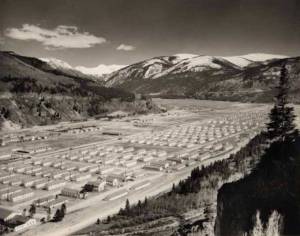N. Conway, NH – Seventy years ago this winter, the legendary American ski troops that would soon be named the 10th Mountain Division were just occupying Camp Hale, the brand new training base in the Colorado Rocky Mountains. Veterans of the 10th Mountain Division from that era from as far away as Washington state will be on hand at the 17th annual Hannes Schneider Meister Cup Race at Mount Cranmore in North Conway, N.H., on Saturday, March 2.
Construction of Camp Hale was just being concluded in late January 1943, and some 16,000 soldiers and 2,500 mules were already in residence. In late December 1942 the War Department issued an order to fill a second regiment of soldiers to be trained in mountain and winter warfare. In an unprecedented arrangement, the Army used a civilian agency, the National Ski Patrol, to serve as a recruiter for the new regiment on the theory that the NSP could better judge skiing ability than non-skiing Army personnel.
The resulting unit, the 86th Mountain Infantry regiment, had sky-high morale and test scores indicating that two-thirds of the 86th enlisted men were officer material. A 1946 Army report noted that “some of our most hard-bitten Regular Army personnel are now frankly admitting that the best men we are receiving …have been endorsed through the National Ski Patrol.”

The soldiers of the mountain infantry had only a short time at Camp Hale to learn the essentials of outdoor winter living before they were assigned to maneuvers in the Homestake Peak area near Leadville, Colo., from February 4 through 12. Those troopers who had already spent one winter training with the 87th Mountain Infantry adapted to both the winter environment and bureaucratic Army methods and thrived on the exercises. In a 2005 memoir Robert W. Parker, later a Vail resort marketing executive, recalled his squad setting up their Army mountain tents in crisp, straight lines that would please the most diligent superior officer, then proceeding to dig snow caves where they slept in warmth and comfort impossible to achieve in the non-breathable, moisture-coated tents.
Other mountain troopers, new to the Colorado high country and with uneven training, had considerable difficulty in adjusting to the altitude, deep snow, and heavy packs. Mountaineering experts sent from Washington as observers submitted a less-than-complimentary report, which in time resulted in changes in the command of the unit. The high point of the maneuvers came as the artillery used its 75 millimeter pack howitzers to bring down a devastating avalanche from Homestake Peak onto the aptly-named Slide Lake. The point was to prove the potential for artillery-induced avalanches as a weapon of mountain warfare, a tactic that would never be used in World War II but which did inspire the use of explosives in postwar civilian avalanche control.
Veterans of the World War II-era 10th Mountain Division are now in their late eighties. The New England chapter of the National Association of the 10th Mountain Division will hold its annual winter gathering in conjunction with the Hannes Schneider Meister Cup Race, and a group of veterans is expected on Saturday to observe the race and mingle with skiers of all ages, as well as active-duty mountain soldiers from the 10th Mountain Division of Fort Drum, N.Y., the 86th Infantry Brigade Combat Team (Mountain) of the Vermont National Guard, and the Army Mountain Warfare School of Jericho, Vt. Those three units of mountain soldiers will participate in the opening ceremony of the event, skiing down with the national and division colors, and compete in the special military category of the Schneider Race.
The Hannes Schneider Meister Cup Race is a benefit event for the New England Ski Museum, which has as part of its mission the remembrance of the 10th Mountain Division, many of whose veterans were instrumental in the postwar development of the alpine and nordic ski industries.

